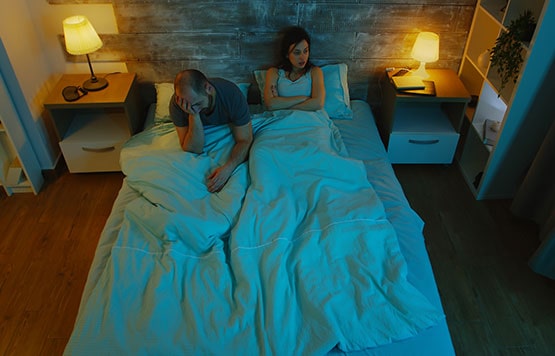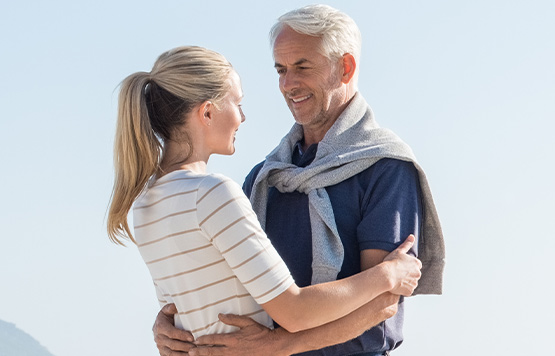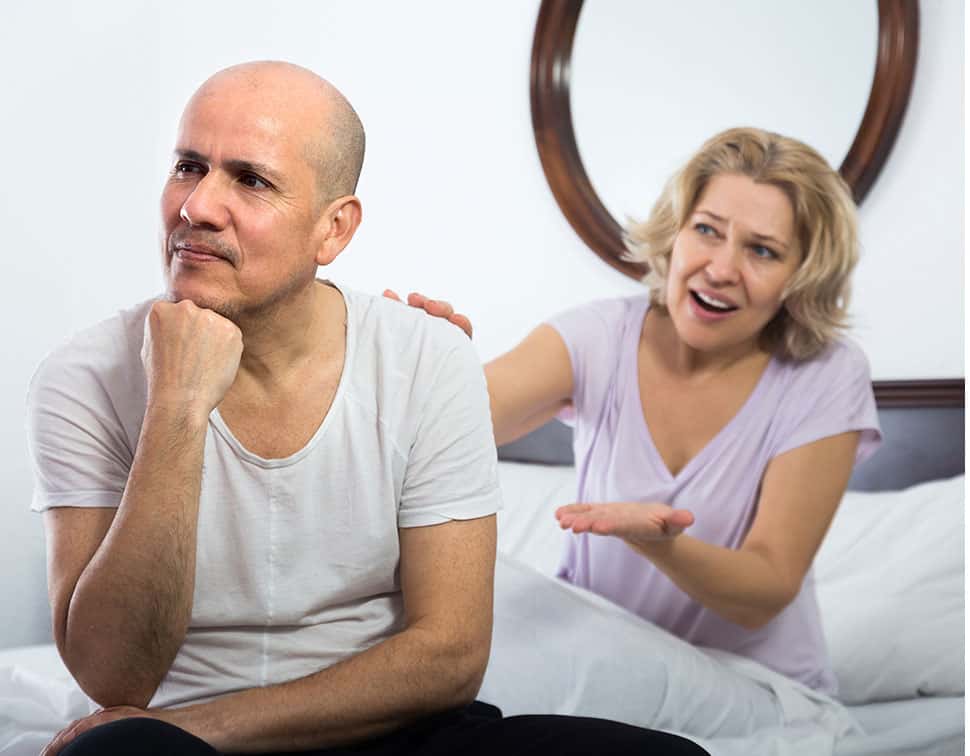We aren't guaranteed much as adults, but if there's one thing we can count on, it's that our bodies change as we get older. For men, that's especially true. One day you're lifting heavy weights and nailing your cardio regimen without having to stretch before or after. And then, in what seems like the blink of an eye, you start to slow down a little. You begin to notice aches and pains in places that weren't there before. You can't just go out for a night on the town, imbibe until your heart is content, and expect to wake up refreshed.
And while headaches and achy joints can be treated with ice and anti-inflammatory medicine, other aspects of aging aren't as easy to treat. You've probably guessed at this point what we're talking about: erectile dysfunction, or ED for short. When brought up to most men, those are two words that cause a guttural reaction of fear and trepidation.
While just about every man fears ED, millions suffer from it - almost 10% of the male population between the ages of 40 and 70. So, if you're beginning to have trouble performing in the heat of the moment, you're definitely not alone. You may be experiencing symptoms like:

Trouble Achieving an Erection

Trouble Maintaining an Erection

Lower Libido

Less Sexual Pleasure

Premature Ejaculation

Inability to Achieve Orgasm
However, at Elite Healthcare Physical Medicine, we understand that stats won't do anything to address the stress and anxiety you're facing in relation to erectile dysfunction. You need a viable solution - a science-backed treatment that doesn't require strange pills or invasive surgeries. As a fully integrated multidisciplinary clinic in Mount Pleasant, we have what you've been searching for: softwave therapy for ED in Isle of Palms, SC.

To fully grasp the benefits of using soft wave therapy for erectile dysfunction, you must first understand what causes ED to begin with. Put simply, erectile dysfunction is the inability to get an erection and keep it throughout sexual intercourse. You should know that it's not uncommon if you have erection trouble. However, if your inability to "get it up" becomes a common occurrence, you may be suffering from ED.
Erectile dysfunction doesn't just affect your penis - it also affects your wellbeing and relationships. It can lower your confidence, cause a large amount of stress that affects your ability to work, and may even cause contention with your partner.
You hear it all the time - as men get older, they often lose the ability to get erect. But why? As men age, the blood vessels in their penis start to fill up with micro-plaques, causing them to deteriorate. When these blood vessels deteriorate, it's more difficult for them to have steady blood flow. And that's the key to ED - having the constant blood flow to get and keep an erection. That's where the science-backed effectiveness of Softwave therapy swoops in to save the day.
Shockwave technology has been around for decades. It has been used at the highest-level research and medical facilities like the Cleveland Clinic and Memorial Sloan Kettering. However, Softwave therapy is a more refined, effective way to treat erectile dysfunction and also advance tissue healing.
Softwave therapy works by using electrohydraulic spark gap technology at its core. Its innovative design features a parabolic reflector applicator that produces very effective, low-intensity shock waves that are unfocused. Elite Healthcare Physical Medicine's Softwave applicator spreads energy to a large area of both superficial and deep tissue, creating a biological response that kickstarts your body's natural healing process.
For men suffering from ED, it is a revolutionary breakthrough treatment that doesn't require harmful surgeries or side effects from pills. In fact, it has been FDA approved for many uses, including improved blood flow, which is often the root cause of erectile dysfunction.
Book Appointment

Unlike some more traditional treatment options, Softwave therapy gets right to the crux of the ED issue. It uses shock wave technology on a cellular level, helping to naturally heal body parts, like the penis. Some of the most common benefits of Softwave therapy include:
Additionally, Softwave treatments don't require much prep, don't have any sketchy side effects, don't require any numbing agents or anesthesia, and result in little-to-no recovery time. Sound too good to be true? Contact Elite Healthcare Physical Medicine today to learn just how effective Softwave therapy is for our patients!

Softwave therapy works by using efficient, effective shock waves that cause biological regeneration processes that heal your body using its own healing factors. It works like this: Softwaves are created via a high-energy electrical discharge in water. The voltage is discharged between the plus and minus tips of an electrode. The spark gap or arching causes an equalization of voltage between the opposing tips of the electrode, which causes a hot plasma bubble. This bubble explodes and distributes in every direction, compresses the surrounding water, and generates a pressure > 10 MPa within nanoseconds.
To sum up, Softwave therapy uses low-intensity, unfocused energy that is delivered by a reflector in parallel waves. These waves help open up the blood vessels in your penis, allowing more blood to flow. At Elite Healthcare Physical Medicine, our team of expert physicians will develop a personalized Softwave therapy plan based on your body and needs. With the right number of treatments, you should be able to achieve and maintain firm erections as you did in your prime.

A Softwave therapy procedure averages 10-15 minutes but may be longer depending on treatment area and diagnosis. A gel is applied to the surface area to be treated. The applicator produces pulses as the clinician moves around the treatment area. During therapy, communication with your provider is necessary to identify treatment areas and monitor progress.
Once treatment is over, you may resume your normal day-to-day activities. In fact, most patients can have Softwave therapy while on their lunch break. You don't have to worry about recovery time, side effects, or any downtime at all.

More than 50% of men will experience erectile dysfunction at some point in their lives. If you're over the age of 30, have been suffering from ED, and don't want to rely on pills or surgery, Softwave therapy may be for you. That's doubly true if you've tried traditional treatments like Viagra and even surgery but didn't get the results you hoped for. Many academic studies about shockwave therapy for ED state that this revolutionary technology is successful where PDE5 inhibitors fail.
In fact, many urologists consider Softwave therapy the most promising ED treatment on the market. The truth is, even if you're not battling ED, men can use Softwave therapy as a preventative way to keep the magic flowing in the bedroom. Some of the key reasons to choose Softwave therapy over less effective, traditional treatments include:
If you're curious why Softwave treatments are so popular for ED, the answer is simple. Prescription drugs like Cialis and others that "treat" ED often come with less-that-savory side effects. At best, these effects are just something patients have to deal with. At worst, they can disrupt your day-to-day schedule and may prevent you from enjoying a healthy life. Sure, some men swear by the "little blue pill," but most guys aren't aware of the hidden risks with drugs like Viagra. The following side effects can be common in both short and long-term circumstances:
If you're suffering through erectile dysfunction, it's crucial to understand why it's happening. The primary reason for ED is a lack of blood flow to the penis, which makes erections difficult to get and keep. Rather than relying on prescription and gas station pills for a quick fix, more men are using softwave ED treatment in Isle of Palms, SC for an all-natural solution minus the side effects. With Softwave therapy, you don't have to live with ED, and you don't have to suffer from scary side effects from popping too many pills.
Book Appointment
Softwave therapy is often a more effective solution for men with ED than similar but less effective treatments using pressure waves. Softwave therapy from Elite Healthcare Physical Medicine uses acoustic pulses or unfocused shockwaves with fast and steep rise times and high positive pressure. Our unfocused wave design makes it possible to spread energy to a larger area, which affects deep and superficial tissue. By targeting a larger area, a more potent biological response is often achieved, initiating your body's natural healing factors.
By comparison, radial pressure waves use acoustic pneumatic pulses with low steeping effects, slow rise times, and large negative pressures. Radial waves are shallower than the shockwaves used in Softwave technology and focus energy and pressure at the surface of the applicator.
Here's a quick breakdown of the differences between softwave therapy for ED in Isle of Palms, SC, and radial pressure waves:

If you're new to the world of Softwave therapy, chances are you've got some lingering questions you need answered. We'll do our best to answer a few of those questions here for your convenience.
Q. Has the FDA approved softwave therapy for ED in cityname, state?
A. Yes - Softwave therapy is FDA 510(k) approved for:
Q. Is softwave therapy painful?
A. Softwave therapy does not require surgery or any invasive form of treatment. With that said, some patients describe minimal discomfort or pain during our softwave treatments. Should this occur, your medical specialist will make necessary adjustments. Usually, patients do not have to endure any pain at all and only experience a pulse or tapping feeling on their skin.
Q. How long is a Softwave treatment session?
A. An individual session only takes five to fifteen minutes. It's typically recommended that patients have treatment once a week for three to five weeks. The length and frequency of your Softwave therapy sessions will be determined after you visit our medical clinic for a comprehensive evaluation.
Q. How long does it take for Softwave therapy to work?
A. Every patient we treat is different, and as such, will have different treatment recommendations. Often, patients notice the results of Softwave therapy after the first session. However, for the longest-lasting effects, most patients need between three and four treatments, with a week of non-treatment after every session.
Q. Can I combine Softwave therapy with other treatments from Elite Healthcare Physical Medicine?
A. It's hard to give a definitive answer to this question since every patient is different. It's important for you to have a full evaluation to determine the scope of your needs and the appropriate therapies. However, Softwave therapy often works very well with other treatments. In fact, other therapies offered at our medical clinic like massage therapy and chiropractic care can make Softwave treatment even more effective.
Remember - our team at Elite Healthcare Physical Medicine is always happy to answer any questions you may have about ED or our ED treatments. Give us a call today - it would be our pleasure to get to know you better!
Unlike some wellness clinics, our experienced providers work together to optimize treatment for men suffering from ED. We always strive to make sexual wellbeing an accessible part of your everyday lifestyle.
That's why, at Elite Healthcare Physical Medicine, our mission is simple: to correct the root cause of your erectile dysfunction by taking a comprehensive, total body approach to healing and treatment. We want to address your ED problem without having to resort to chemical-based medications or unnecessary surgeries. Instead, we focus on all-natural, effective solutions like shockwave therapy for ED in Isle of Palms, SC.
By discovering what's best for each person's individual body and needs, we can help create a healthier future for those in our community through our holistic physical medicine practices. Contact our office to learn more about Softwave therapy and how we can solve the underlying causes of your unique ED situation.
Book AppointmentPublished: Jan. 16, 2025 at 1:45 PM PST|ISLE OF PALMS, S.C. (WCSC) - Federal, state and local beach advocates are workshopping how to prioritize the protection of beachfront access along some of the Southeast’s most beloved waterfronts.The 11th annual South Carolina Beach Advocates conference opened its panel on Thursday. The conference began more than a decade ago with the intention of consolidating funding and beach management along the state’s coastline, something Administrator Nicole Elko said did not exist when...
Published: Jan. 16, 2025 at 1:45 PM PST|
ISLE OF PALMS, S.C. (WCSC) - Federal, state and local beach advocates are workshopping how to prioritize the protection of beachfront access along some of the Southeast’s most beloved waterfronts.
The 11th annual South Carolina Beach Advocates conference opened its panel on Thursday. The conference began more than a decade ago with the intention of consolidating funding and beach management along the state’s coastline, something Administrator Nicole Elko said did not exist when she took on the role.
“We’re all looking for funds, we’re all battling the same issue. Permitting takes a long time, projects take a long time and projects cost a lot more than they used to. It’s hard in these small communities and we need the state’s help,” Incoming Chair and Mayor of Isle of Palms Phillip Pounds said.
Several of the local communities have set up projects involving the U.S. Army Corps of Engineers, who attended the conference. In a keynote speech, the group announced its most recent effort to renourish and preserve the shoreline in Myrtle Beach.
The $72 million project will cover 26 miles of the beachfront.
“Our beach projects, a lot of people go there to recreate and play, we know it’s a big economic driver for the state of South Carolina and the nation, but really the reason we build beaches is not just to recreate, it’s to protect the infrastructure behind the dunes,” Chief of Civil Works Jeff Livasy said.
This year, the group is hoping to implement long term, state commitment and create proactive initiatives rather than banking on emergency funding or projects. Elko said Governor Henry McMaster appropriated $5 million into the efforts this year, and previously, up to $50 million.
Eleven Lowcountry communities, including Georgetown, Hilton Head, Myrtle Beach, Kiawah Island, Isle of Palms, Folly Beach, Edisto Beach, Pawleys Island, Sullivans Island and the DeBordieu Colony Community Association, presented their findings from the past year.
Many of the beach access points faced detrimental challenges after the longterm impacts of inclement weather, including Hurricane Ian, a Nor’Easter in 2023 and Tropical Storm Debby in 2024.
Kiawah Island Mayor Brad Belt claimed its strongest struggles come from how to manage natural resources both on the marsh side and beach shoreline. The area suffered from inundation along the one major roadway which provides a single entry and exit point to islanders. Uniquely, the area is also mostly private owned spaces, with only an exception of Beachwalker Park, and the town’s 3 miles of roadway and 21 acres of land. This complicates efforts to use public sector funding to preserve the area.
Isle of Palms Administrator Douglas Kerr reported a continued concern for beach erosion along the Wild Dunes resort and Breech Inlet. The group has attempted improvements with a beach preservation ad hoc committee. Despite this, Kerr believes there needs to be money and permits in place to create strategies before a storm passes through and causes detrimental damage.
Folly Beach Administrator Aaron Pope mentioned a continuous cycle of efforts to renew and manage the beach, however political will and a lack of staff creates challenges for submitting grant applications or educating the community on efforts.
Sullivans Island Administrator Joe Henderson claimed similar issues with erosion on the eastern and western ends of town, plus stormwater management concerns. The town will move forward on plans to construct native stormwater infrastructure within the next two or three years.
The other seven panelists reference similar issues crowding their ability to preserve shorelines.
“You’re trying to outguess Mother Nature, you’re trying to anticipate a storm ‚and save as much money as you can while spending money on other projects as well. It’s a constant story to have to tell, the economic impact beach communities have,” Pounds said.
South Carolina beaches attract more than 140 million visitors every year, according to Elko’s findings. This generates $23.8 billion in economic impact for the state.
Elko also claimed beach tourism contributes $1.2 billion in state tax revenue, representing two-thirds of the state’s total tourism revenue. Tourists generate more than $1200 in economic development for every $1 invested into beaches, and more than $250 in state taxes for every $1.
The goal, Elko said, of the conference is to create resilience funding to protect the state’s most valuable asset for future generations.
The conference will continue into Friday. The group will hear from legislators and Governor Henry McMaster.
The next annual conference will be held Jan. 2026 in Hilton Head.
Copyright 2025 WCSC. All rights reserved.
South Carolina has a mystical, compelling charm like no other state in America. It is full of teeny towns with classic southern charm, whether it’s inland or coastal. There’s no shortage of things to do and see in and around these lovely little towns. From the historical downtown of Beaufort to the luxurious beach resorts of Isle of Palms and the gorgeous mountain scenery of Landrum, discover these South Carolina towns and unravel their secrets.Beaufort ...
South Carolina has a mystical, compelling charm like no other state in America. It is full of teeny towns with classic southern charm, whether it’s inland or coastal. There’s no shortage of things to do and see in and around these lovely little towns. From the historical downtown of Beaufort to the luxurious beach resorts of Isle of Palms and the gorgeous mountain scenery of Landrum, discover these South Carolina towns and unravel their secrets.
Beaufort is located on Port Royal Island and is the second oldest city in South Carolina. Its entire downtown is a designated historic district by the National Trust for Historic Preservation, so it is a natural choice destination for history buffs! Visitors can stop by the Beaufort Visitor Center and pick up a guide for a self-guided tour around the homes of the historic district before venturing over to the Beaufort History Museum, originally an arsenal. Lunch at Bricks on Boundary or the cute corner café, Blacksheep, will keep travelers satiated for a walk around the nearby Hunting Island State Park. The park features 3 public beaches, a lighthouse, a fishing pier, and nature trails that the whole family can enjoy. Stay at the top-rated 607 Bay; a bed and breakfast that also organizes charters or kayaking adventures for guests.
Known for being a gently developed beach along the South Carolina Coastline, Edisto Island is a perfect destination for anyone looking to be surrounded by beachy nature without all the hype and tourism. There are no hotels on Edisto Island, so visitors can choose to camp at Edisto Beach State Park or stay at a rental beach house advertised on Edisto Realty. Travelers love the easy flow of biking down the 5-mile Edisto Island Bike Path which winds around the back side of town. Rentals are available at Island Bikes and Outfitters. McConkey’s Jungle Shack is a local favorite for beachy drinks and classic sandwiches.
Home to Coker University, Hartsville is a small town in north central South Carolina that attracts visitors for its history, outdoor recreation, and charming downtown. A stay at the Mantissa Executive Suites & Spa is an intimate boutique hotel to spend evenings at with a rooftop bar and it is conveniently located across the street from The Blind Pig, serving up classic American fare and fabulous cocktails. In the mornings, travelers can grab a tasty coffee at Crema before heading to Kalmia Gardens, a public botanical garden with trails that wind through a variety of animal and plant life.
An hour north of Charleston, Isle of Palms is known for its world-class luxury for guests; from its top-notch golf courses to award-winning spas, Isle of Palms is for the lavish traveler. Wild Dunes Resort, the 1600-acre retreat, has two golf courses, a full-service spa, 1 clay tennis court, and 5 pickleball courts. The public Isle of Palms beach is great for sunbathing or catching a sunrise. The Islander is a rowdy way to end a day out in Isle of Palms with your friends and family; they have consistent live music, trivia nights, and delicious seafood sharables or main dishes like ahi tuna Bruschetta or local Oysters.
Walhalla or “Garden of the Gods” is a lovely mountain town in upstate South Carolina. Visitors can plan to book ahead for a one-of-a-kind stay in the Majestic Treehouse, a cozy cottage surrounded by 40 acres of forest, creeks, gardens, and trails to wander. In town, guests will find the Museum of Cherokee and Oconee History Museum or fun shops like Sunni Ann Mercantile Company. Nearby Sumter National Forest is a haven for hikers in the Southern Appalachians with waterfall views on trails like Big Bend Falls and Foothills Trail.
A small town dedicated to art in action, Lake City is a visual experience. Visitors to Lake City will find painted murals and sculptures like “Geisel’s Garden” throughout town, along with accessible art centers featuring exhibitions at Acline Studios or Trax Visual Art Center. Piggyback’s BBQ & Catfish is a local hub for southern fare with delicious bbq platters and catfish baskets. Overnights at the artfully designed 'The Inn at Crossroads,' will put travelers in the middle of downtown with an in-house bar and restaurant, Lake City Bistro. At Riverrat’s, kayaks and paddleboards are available for rent to paddle along the Lynches River.
In the piedmont of South Carolina, Laurens is a tight-knit, growing town of welcoming locals. Laurens has a rich history that can be tracked through the walls and exhibits of Laurens County Museum or sites like the Battle of Musgrove Mill State Historic Site, the location of the Battle of Musgrove Mill, around half an hour away. Whiteford’s Giant Burger is a legendary spot to grab a hearty burger, serving customers since 1957 with quality being their highest priority. At Lake Greenwood State Park, anglers can rent equipment and catch a variety of fish: bass, crappie, bream, perch, catfish, or stripers.
Founded in 1880 and situated against the southern end of the Blue Ridge Mountains, Landrum is a delightful little town and a breath of fresh air. Hikers base themselves in Landrum to trek the popular Palmetto Trail’s Blue Wall Passage, a 14-mile moderate trail featuring a 30-foot waterfall. Post-hike food fuels are best fulfilled at Southside Smokehouse, known for its variety of specials and Cajun-inspired recipes. The Landrum Farmers Market is not to be missed on Saturdays from April through December featuring live entertainment, homemade foods or crafts, and fresh produce.
The scattered small towns of South Carolina offer a variety of landscapes, the famous southern charm from welcoming locals, and a kind of mysticism in the air that’s unmistakable and alluring. From the upstate southern end of the Appalachia’s to the relaxed Atlantic coastline, South Carolina truly has a small town for all kinds of kinds. South Carolina’s small communities have a way of carving unforgettable memories into all who wander around them.
Share
In suburban Philadelphia where I grew up, going to the beach meant driving east across New Jersey, paying per-person fees for access and pinning "beach tags" to bathing suits to prove the fees had been paid.I've long appreciated South Carolina's free public beaches, first as a child visiting most summers, then as an adult living here more than 20 years.But while the...
In suburban Philadelphia where I grew up, going to the beach meant driving east across New Jersey, paying per-person fees for access and pinning "beach tags" to bathing suits to prove the fees had been paid.
I've long appreciated South Carolina's free public beaches, first as a child visiting most summers, then as an adult living here more than 20 years.
But while the beaches are free, parking can be costly.
Just days ago Anna Sharpe reported that the Isle of Palms has increased its parking lot rate to $25 on a Saturday, Sunday or holiday from Memorial Day through Labor Day. Parking meters must be fed $3 per hour.
The $25 cost for parking lots matches the rate at the 445-parking-space Isle of Palms County Park, which is adjacent to the city's metered parking and lots near Front Beach (Ocean Boulevard) businesses.
That's expensive, but the important thing to know is that paying for parking on the Isle of Palms is almost entirely a matter of personal choice. I mean, you can't avoid paying if you park in a lot or at a meter, but you don't have to park there.
IOP, like neighboring Sullivan's Island, has many hundreds of free parking spots in the public right-of-way. On the Isle of Palms most of them are along Palm Boulevard on the east side of the business district, from 21st to 40th avenues and from 42nd to 53rd avenues.
There are limited spots on the west side of the island, along 3rd through 9th avenues between Ocean and Carolina boulevards.
Those who park in the free spots should know that parking enforcement is quite strict, and vehicles must be at least 4 feet off the pavement, which isn't always easy.
Last year the city's contracted parking enforcers — a company that got to keep 24 percent of the money from fines — issued more than 5,600 tickets for between $50 and $100 each.
One option to avoid fees and parking tickets on weekends is to take the free Beach Reach shuttle bus from Mount Pleasant Towne Centre, at Market Center Boulevard, where parking is free. If you're driving, it's of course inconvenient to stop just minutes from the beach and wait for a bus to take you there, but it does solve the parking dilemma.
When my family was living in Mount Pleasant with a young child, the Isle of Palms was our closest beach. We usually parked in the county park lot, or in a free space not far away, for two reasons: the availability of lifeguards and bathrooms.
People can use the county park and its services without paying to park there, and county residents can park there for far less than the advertised rate.
For regular beach-goers and, I would think, most families with children, a Charleston County parks Gold Pass is a great option. For $80 — $65 for those age 60 or older and $95 for non-residents — that covers parking and park entrance fees for a year, for up to 15 people per vehicle.
A Gold Pass includes festival admissions, too, and comes with discounts on things such as equipment rentals.
So, for those who live here, it doesn't have to cost money to park at the beach. And regular visitors to the Isle of Palms who want amenities and lifeguards should consider buying a Gold Pass.
ISLE OF PALMS — Prepare to pay more to park for trips to the beach this summer.The city of Isle of Palms approved a fee increase for the city's two lots and on-street parking, bringing the cost to park on a peak-season weekend up to $25.Daily rates for the municipal parking lots on Pavilion Drive will remain at $10 for March and April.Memorial Day through Labor Day, which is consi...
ISLE OF PALMS — Prepare to pay more to park for trips to the beach this summer.
The city of Isle of Palms approved a fee increase for the city's two lots and on-street parking, bringing the cost to park on a peak-season weekend up to $25.
Daily rates for the municipal parking lots on Pavilion Drive will remain at $10 for March and April.
Memorial Day through Labor Day, which is considered peak season, rates will increase to $15 during the week and $25 on Saturday, Sunday and holidays.
After Labor Day, rates will drop back to $10 for the rest of September and October. Parking will remain free in the offseason from November through February.
On-street parking will be more costly, too. Paid parking spots along Ocean Boulevard between 10th and 14th Avenue will rise from $2.50 per hour to $3 per hour.
The $60 seasonal parking passes, which allowed beachgoers to park in the municipal lots without daily payment, will now only be available to island employees. In its place, visitors can purchase a weekly pass for $100.
No fees or permits are required to park in the public rights-of-way, including the marked spaces along Palm Boulevard.
The city brought in over $1,300,000 in parking revenue in 2024, a roughly $47,000 increase from funds collected from paid lots and meters in 2023.
The rise in parking fees is meant to bring the city's rate to where the city "should have been in the first place," Councilman Jimmy Ward said during the meeting.
The fee increase is the first since 2020. City leaders voted to increase parking to its current rates of $2 an hour on-street, $10 during the week and $15 on weekends and holidays.
Before that, the lots cost $1 an hour and on-street parking spaces were $1.50 per hour.
The city also raised the prices of fines for parking violations to its current rates, which will not be impacted by the council's Jan. 28 decision.
Officials at the time said the fee increase was done to control the "unbridled growth" across the tri-county area.
"Our residents want us to do something about trying to control what's been happening to our island," Jimmy Carroll, then-mayor of the island, said at the time.
Mayor Phillip Pounds said the new rates model those of the Isle of Palms County Park, a Charleston County operated park with a 445-car capacity parking lot. Parking can cost up to $25 on holidays and weekends during the summer.
Visitors can purchase a Gold Pass from the county for $80 for Charleston County residents and $95 for non-residents, which allows visitors to bypass admission fees for several parks, including the Isle of Palms.
The decision to increase parking fees comes at a time when coastal communities are working to find funding for beach maintenance and renourishment projects.
Rising costs of mobilization and sand have pushed beach communities get creative in order to fund preservation measures, which leaders discussed during a South Carolina Beach Advocates conference on the Isle of Palms in January.
An estimated $60 million in locally funded beach management projects are slated for the Palmetto State's coastal communities this year, including roughly $3 million on the Isle of Palms.
More fee increases could be on the way for the Isle of Palms to help fund its next large-scale beach renourishment project, based on recommendations from the city's Beach Preservation Ad Hoc Committee.
"To be as proactive as the community would like to be has an enormous price tag," Interim City Administrator Douglas Kerr said on Jan. 16. "We have to raise revenues to fund all of these initiatives, and that's going to be a very tough part of this project."
Some gated communities, like Seabrook and Kiawah Island, pull from homeowners' and property owners' fees, while Pawley's Island relies on accommodations taxes to fund beach renourishment projects.
Protecting the South Carolina coast is a priority for many, including coastal community leaders, environmental advocates, state and federal lawmakers, and the U.S. Army Corps of Engineers. This week, these stakeholders are gathering at Wild Dunes on the Isle of Palms for the 11th annual South Carolina Beach Advocates meeting. (WCIV)ISLE OF PALMS, S.C. (WCIV) — Protecting the South Carolina coast is a priority for many, including coastal community leaders, environmental advocates, state and federal lawmakers, and the U.S. Army Co...
Protecting the South Carolina coast is a priority for many, including coastal community leaders, environmental advocates, state and federal lawmakers, and the U.S. Army Corps of Engineers. This week, these stakeholders are gathering at Wild Dunes on the Isle of Palms for the 11th annual South Carolina Beach Advocates meeting. (WCIV)
ISLE OF PALMS, S.C. (WCIV) — Protecting the South Carolina coast is a priority for many, including coastal community leaders, environmental advocates, state and federal lawmakers, and the U.S. Army Corps of Engineers. This week, these stakeholders are gathering at Wild Dunes on the Isle of Palms for the 11th annual South Carolina Beach Advocates meeting.
IOP Mayor Phillip Pounds emphasized the importance of preserving the coastline, describing the area as "a slice of paradise" with its seven miles of beach, easy access, ample parking, and vibrant local businesses.
However, maintaining the beachfront is both challenging and costly. Mayor Pounds revealed that the city plans to participate in a $20 million renourishment project next year, with the city bearing a significant portion of the cost. He expressed a desire for the state to play a more active role in funding such initiatives.
"For us not to have an ongoing state-level funding mechanism for beach renourishment is something that needs to change," said Pounds. "That's one of the main focuses of this group."
Pounds noted that future renourishment spending could reach $200 million in the coming decades. While the city plans to fund most of the work for now, Pounds acknowledged the need for external assistance.
READ MORE | "South Carolina DPH offers free OD safety kits to combat rising opioid overdose deaths"
"We can't tax our way out of that scenario. We can't bring enough short-term rentals. We can't bring enough tourists to the island to pay for that," he said.
The city is exploring partnerships with the state and other entities, including early discussions with the U.S. Army Corps of Engineers. Several other coastal communities have already partnered with the Army Corps.
Jeff Livasy of the Army Corps of Engineers highlighted the significance of their work in the region. "It means everything to us. Although we're a part of the federal government, we live, work and play here in the Lowcountry," Livasy said.
The Army Corps' Charleston division recently completed a renourishment project on Folly Beach. Livasy emphasized their long-term commitment to coastal projects, stating, "We partner with them for the long term. Not just annual projects. But some of our projects have a fifty-year life."

